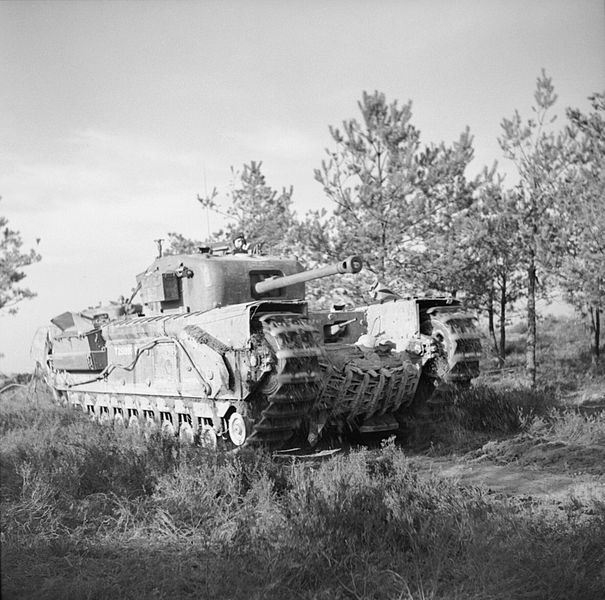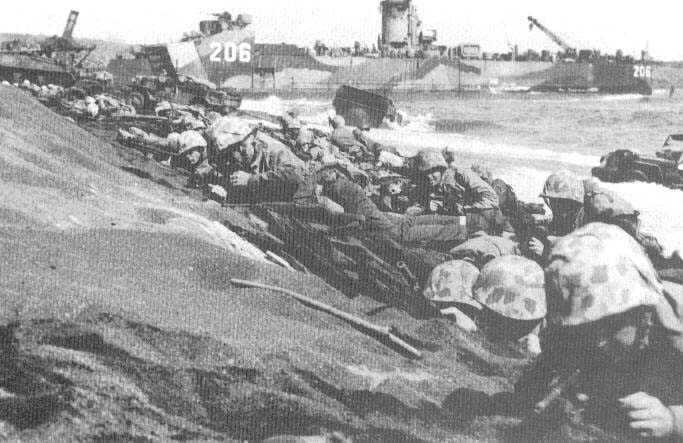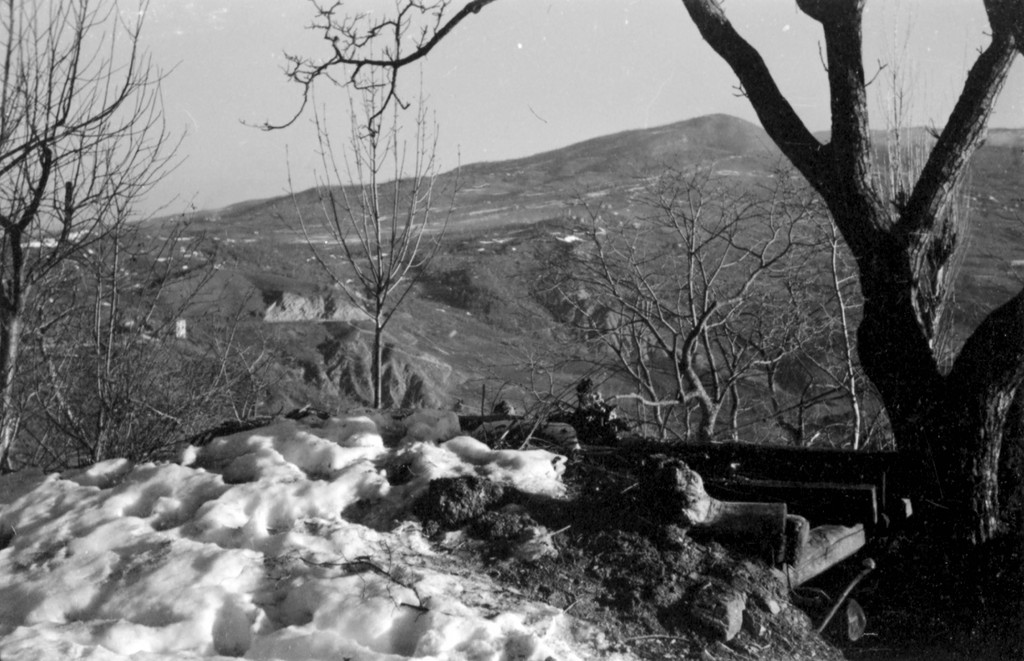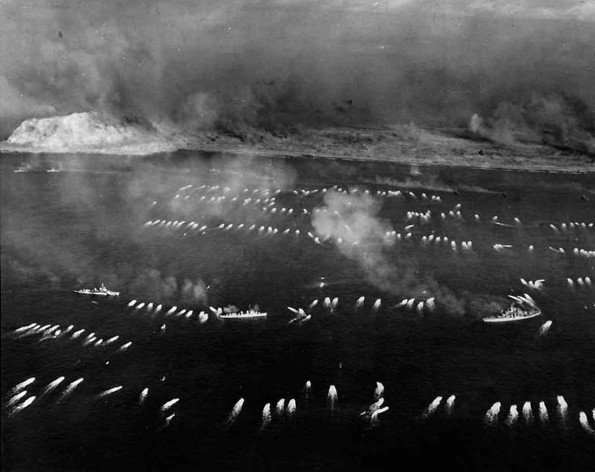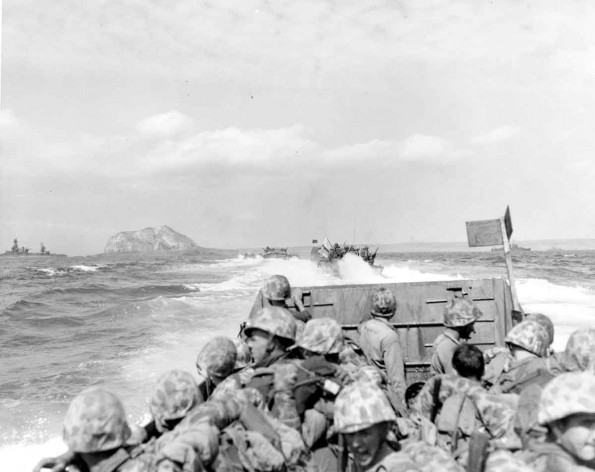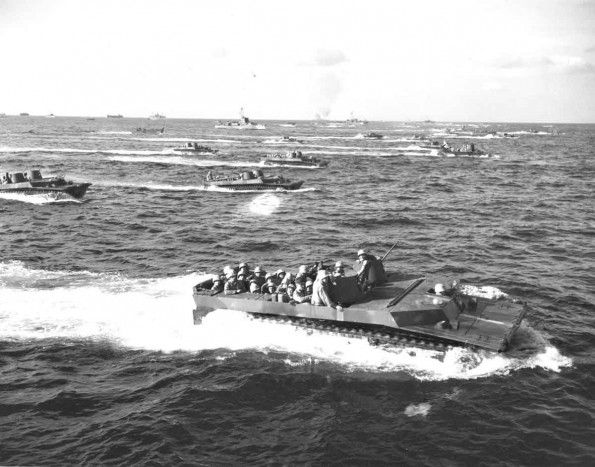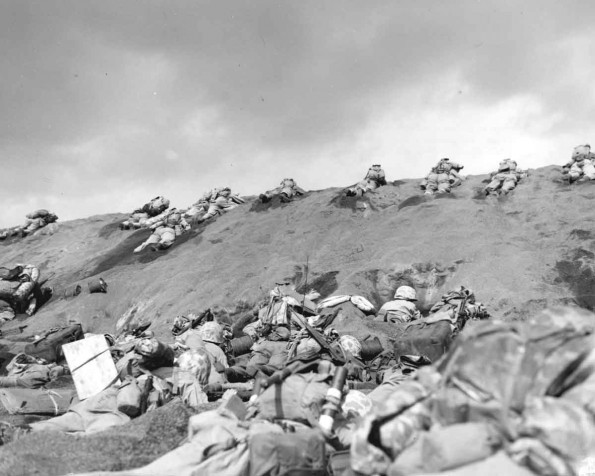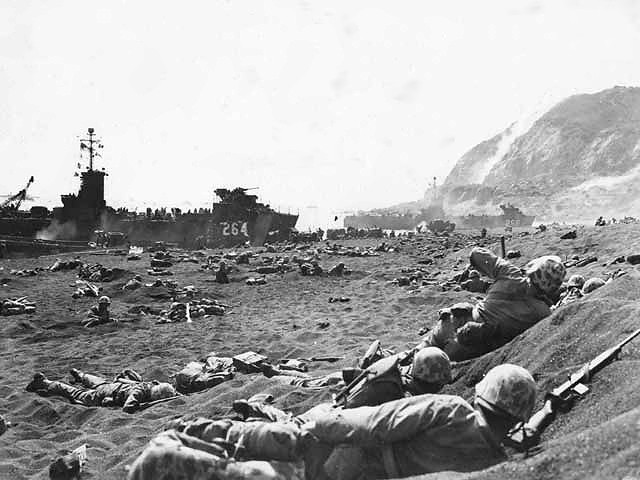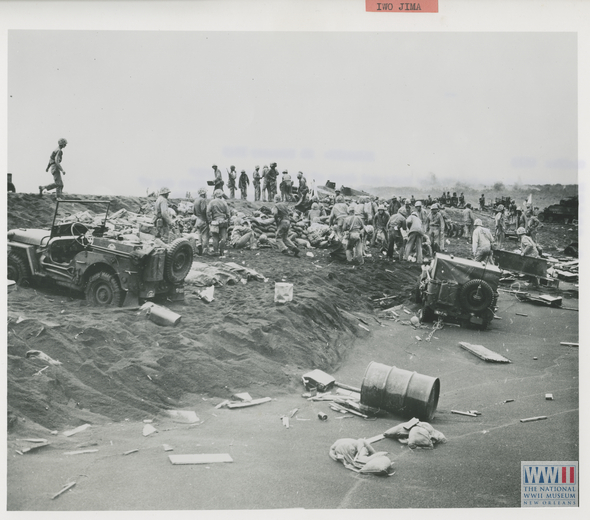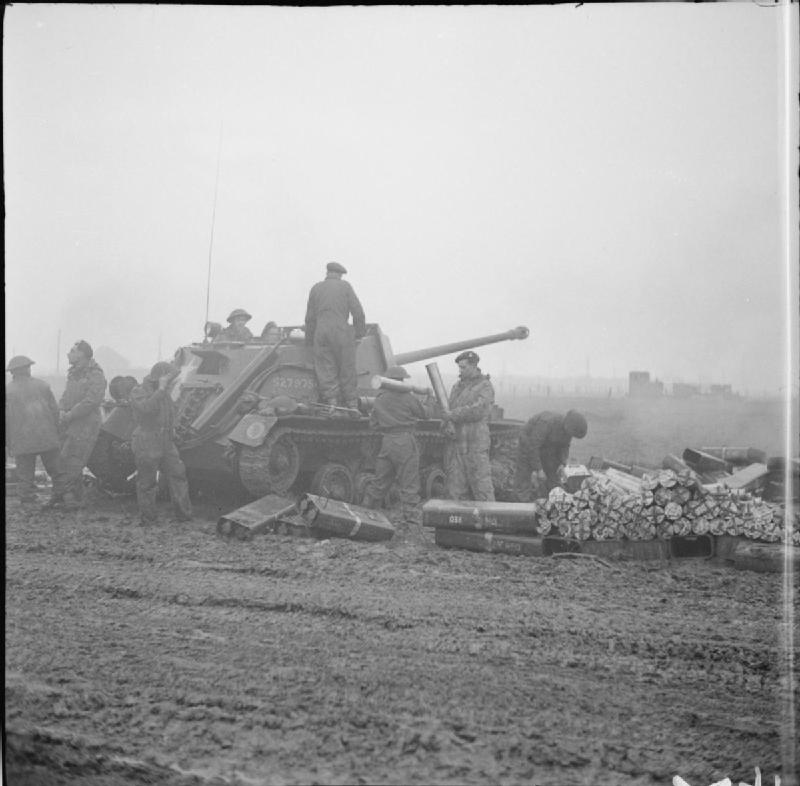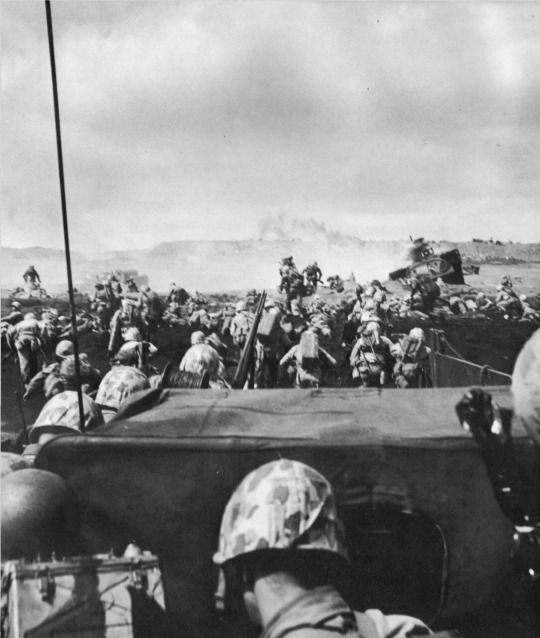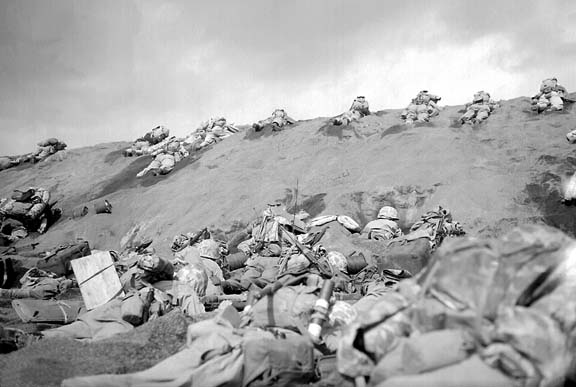Air Operations, Bonin Islands
During the morning, 24 US Navy fighters from the USS Hancock (VF-80) and the USS Lexington (VF-9) attack airfields and small vessels at Chichi Jima and Haha Jima. 5 of these fighters are lost in operational mishaps and a TBM command plane is shot down by anti-aircraft fire.
[Air Operations, CBI
BURMA- 24 10th Air Force B-25s and 31 10th Air Force P-47s support Allied ground forces in the Mongmit and Myitson areas.
- More than 70 fighter-bombers attack numerous targets throughout central Burma.
- 14 14th Air Force P-51s attack rail and river traffic.
Air Operations, East Indies
XIII Bomber Command B-24s attack the Miri airfield on Borneo.
[Air Operations, Europe
RAF BOMBER COMMANDDaylight Ops:
- 168 Lancasters of No. 3 Group carru out a good attack on Wesel with the best concentration of bombs being in the railway area.
- 1 Lancaster is lost.
- 1 Halifax flies an RCM sortie.
- 254 Lancasters and 6 Mosquitos of No. 5 Group are sent to Böhlen. This raid is not successful, probably because the aircraft of the Master Bomber, Wing Commander E. A. Benjamin, is shot down by flak over the target. Post-raid reconnaissance shows that damage to the target was 'superficial'. There is no evidence to show where the main bombing fell.
- 1 Mosquito is lost.
- 82 Mosquitos are sent to Erfurt and 24 in small numbers to 6 other targets, and there are 29 Mosquito patrols and 9 RCM sorties.
- There are no losses.
GERMANY:
- 246 1st Air Division B-17s attack oil-industry targets at four locations (primaries).
- 162 1st Air Division B-17s attack a marshalling yard at Münster (secondary).
- 86 2nd Air Division B-24s attack a munitions plant.
- 97 2nd Air Division B-24s attack an armaments factory.
- 94 2nd Air Division B-24s attack a marshalling yard.
- 179 3rd Air Division B-17s attack marshalling yards at Osnabruck (primary) and Münster (secondary).
- 131 3rd Air Division B-17s attack a marshalling yard at Rheine.
- 68 3rd Air Division B-17s attack a rail bridge at Wesel.
- 10 3rd Air Division B-17s attack targets of opportunity.
- 1 B-24 and 7 of 358 VIII Fighter Command escorts are lost.
GERMANY:
- 9th Air Division bombers attack rail bridges at three locations, an ordnance depot, a motor-vehicle depot, and targets of opportunity.
- 9th Air Force fighters and fighter-bombers attack bridges and rail lines.
ITALY:
- 12th Air Force B-25s are grounded by bad weather, but XXII TAC P-47s using radar-control techniques are able to mount limited attacks through heavy clouds against dumps and communications targets in the Po River valley and rail lines in Brenner Pass.
- During the night, XXII TAC a-20s and A-26s attack more than 30 targets of opportunity in the Po River valley and marshalling yards and railway lines at ten locations.
AUSTRIA:
- 15th Air Force heavy bombers attack rail targets in Vienna and mashalling yards at three locations.
- 15th Air Force heavy bombers attack shipyard facilities at Fiume.
- 15th Air Force P-38 and P-51 pilots are credited with the destruction of a record 31 locomotives during strafing attacks over enemy territory.
- 15th Air Force heavy bombers attack a marshalling yard at Maribor and the harbor and military installations at Pula.
Air Operations, Formosa
- Thwarted by bad weather over the Heito airfield, 3 V Bomber Command B-24 groups attack the airfields at Koshun and Takao.
- 38th Medium Bomb Group B-25s and fighter-bombers attack numerous targets of opportunity throughout the island.
Air Operations, Japan
- Undertaking a diversionary strike in support of the invasion of Iwo Jima, 150 XXI Bomber Command B-29s are dispatched against an aircraft factory near Tokyo. Due to thick cloud cover over the target, 119 B-29s release their bombs over port and city areas of Tokyo and 12 B-29s attack targets of opportunity and last resort.
- 6 B-29s are lost.
- 6 28th Composite Bomb Group B-24s attack the Kurabu Cape airfield while conducting a photo-reconnaissance mission over the Kurile Islands.
Air Operations, Malaya
49 of 59 58th Very Heavy Bomb Wing B-29s dispatched attack railroad repair shops at Kuala Lumpur with 176 tons of bombs from as low as 1,000 feet. 4 of the B-29s attack the Alor Star airfield and a marshalling yard at Martaban, Burma.
[Air Operations, Philippines
- 26 FEAF B-24s based at Angaur attack the Likanan airfield on Mindanao.
- V Bomber Command B-25s and A-20s support US 6th Army ground forces on Luzon and Corregidor.
- 1st Marine Aircraft Wing F4Us attack airfields and other targets in the central Philippines with napalm.
- Aerial bombs penetrating an underground barracks on Corregidor are credited with killing 500 Japanese Army soldiers in a single blow.
- 1st Marine Aircraft Wing SBDs based at the Mangaladan airfield on Luzon make their first use of an airborne air-support coordinator during a close-air-support mission in support of US 6th Army ground forces. The experiment is deemed a success, and the technique is employed thereafter on an expanded though ad hoc basis.
- A 547th Night Fighter Squadron P-61 crew downs a G4M 'Betty' bomber near Cabanatuan at 2055 hours, and a second 'Betty' near Baguio at 2135 hours.
Baltic
U-676 sinks after hitting a mine in a Soviet-laid mine field in the Gulf of Finland.
| Class | Type VIIC |
| CO | Kapitänleutnant Werner Sass |
| Location | Baltic, Gulf of Finland |
| Cause | Mine |
| Casualties | 57 |
| Survivors | None |
Burma
The Japanese put in a determined counterattack against the bridgehead opened by the 25th Indian Div at Ru-ywa in the Arakan sector.
[Diplomatic Relations
Himmler makes his first peace overtures to Swedish Count Folke Bernadotte of the Red Cross.
[Eastern Front
The forces of the German Army Group E are considerably reduced by the transfer of reinforcements from Yugoslavia to Hungary, but the positions are generally maintained.
In Silesia the Russians continue their attacks against the garrison of Breslau and northwest of the city.
The 2nd Belorussian Front in East Prussia puts in vigorous attacks against the Germans crossing the Samland peninsula, the tongue of land that joins Königsberg with Danzig, who are trying to fight their way out to the west. In northwest Poland the Russians surround Grudziadz and press on northward in the direction of Danzig (Gdansk), opposed by the Vistula Army Group.[MORE]
[Philippines
On Luzon fighting in Manila continues. Forces of the 25th Div, US I Corps, supported by aircraft and artillery, open operations against the Japanese positions northwest of Lumboy.
Some Japanese counterattacks at Corregidor are repulsed.
The US 8th Army begins a series of amphibious operations to clear all the Japanese from the San Bernardino Strait, between the islands of Samar and Luzon.
On Leyte the Americans are still engaged in eliminating the last pockets of Japanese resistance.
.Over the next 2 days there are US landings in the northwest of the island of Samar and on the small islands offshore of Dalupiri, Capul and Biri. There is some resistance on Biri.
[United States, Home Front
The US government requests all public amusements to observe midnight curfew.
[Western Front
Units of the British XXX Corps, Canadian 1st Army, continues the battle for Goch against tenacious opposition by the German 1st Parachute Army.
Units of the 80th Div, XII Corps, US 3rd Army, take Hommerdingen, Nusbaum and Niedergegen, and the 5th Div takes Stockem. After strong artillery preparation the XX Corps goes on to the offensive to liberate the triangle between the Saar and Moselle Rivers.
[Air Operations, Volcano Islands
The heaviest pre-landing bombardment of World War II begins against Iwo Jima at 0640 hours, when 7 US Navy battleships and a vast array of lesser vessels open fire under the guidance in many cases of VOC-1 spotter fighters. Of 44 VII Bomber Command B-24s dispatched on a last-minute predawn strike against Iwo Jima, only 14 are able to locate targets through thick cloud cover, and the remaining 30 abort. Next, between 0805 and 0815 hours, in the final pre-landing air attack, 24 VMF-124 F4Us and 24 Fleet Carrier Air Group 4 F6Fs (USS Essex) mount low-level rocket and strafing runs against the landing beaches just ahead of the lead US Marine landing waves. At 0900 hours, following an intense final pre-invasion bombardment, two divisions of the V Marine Amphibious Corps land against increasingly intense opposition. Many carrier aircraft from Task Group 58.2 and Task Group 58.3 attack other areas of Iwo Jima just before and during the landings. (Each F6F is armed with one 500-pound bomb and 6 5-inch rockets). And throughout the day, US Navy and Marine Corps aircraft from Task Force 58 mount a total of 602 effective sorties against Iwo Jima in 28 separate missions, delivering more than 137 tons of bombs and rockets, and 104 napalm bombs. Task Group 55.2 escort-carrier aircraft also mount several hundred effective combat sorties against Iwo Jima and Chichi Jima, and many serve as target-coordination aircraft for both combat-air and shore-bombardment missions.
Between approximately 1900 and 2130 hours, several individual bombers based in Japan attempt to reconnoiter and attack the US invasion fleet. A VF(N)-90 F6F downs a Ki-49 'Helen' bomber 20 miles from Task Force 58 at 1926 hours, and 2 other bombers are downed by anti-aircraft fire.
[Iwo Jima
At 9:00a.m., after an extremely powerful preparation in which 6 battleships add to the firepower, the American V Amphibious Corps, escorted by the 5th Fleet under the command of Adm Raymond A. Spruance and commanded for the combined operations by Vice-Adm Richmond K. Turner and for the land operations by Gen Harry Schmidt, lands part of the 4th and 5th Marine Divs on the southeast coast of the island, strongly fortified by the Japanese. Japanese resistance at first is negligible, but it increases in ferocity as the Marines begin their move inland from the beaches. The landing force suffers heavy casualties, especially on its right flank. The units on the left flank try to advance southward toward Mount Suribachi, a feature that dominates the whole island. Tanks and artillery go into action the moment they land.
The landing force consists of 30,000 men. They are carried in Adm Harry W. Hill's TF 53 and land on the southeast of the island. Facing them, in the shelter of a forest of underground fortifications accurately sited and linked by tunnels - a real ants' nest - are 21,500 men, 14,500 of them from the army, 109th Inf Div, 2nd Mixed Bde from Manchuria, 145th Independent Mixed Regt, 1 tank regiment with 30 medium and 10 light tanks, 3 mortar battalions and 5 anti-tank battalions, and 7,000 from the navy, technicians, pilots without aircraft and seamen without ships, hastily trained by the army. The naval troops are commanded by Read-Adm Toshinosuka Ichimaru; Commander-in-Chief of the garrison is Gen Tamadichi Kurabayashi.
The island, in the Volcano group, covers less than 12 square miles. 8 square miles of the island is completely fortified. It has 2 airfields, with a third under construction. It is dominated by the hill called Mount Suribachi (560 ft), at the southwestern extremity. To the north is a plateau about 300 feet hight, the Motoyama plateau. There is hardly any vegetation; the volcanic nature of the terrain gives the island a lunar appearance. Why have the Americans decided to land here? There is a psychological motive; the loss of Iwo Jima, which is part of metropolitan Japan, could have a serious effect on the enemy's morale. And there is a strategic motive: from Iwo Jima American long-range fighters will be able to reach Japan and escort bombers there, and the bombers too will find it helpful to have a staging-post on the long route they have to cover to carry out their frequent missions against Japan.
In the operations connected with the Iwo Jima landing the heavy cruiser Chester (CA-27), the destroyer Bradford (DD-545), the destroyer John W. Weeks (DD-701) and the destroyer escort Finnegan (DE-307) are damaged.
There is almost no resistance to the landings at first, but after about half an hour the defenders open fire. The increasingly fierce Japanese resistance fails to prevent the Marines consolidating their beachhead and fighting their way across to the other side of the island before the end of the first day.
[Images from February 19, 1945
|
|
|
|
|
|
|
|
|
|
|
|
